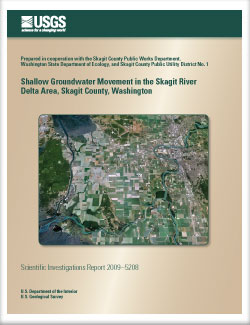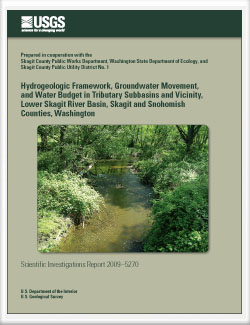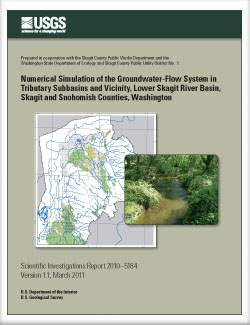Instream
Flow and Groundwater Management Program

Skagit Instream Flow in the News
 |
Background
The Washington Department of Ecology (Ecology) established the Skagit River Instream Flow Rule (Chapter 173-503 WAC) with an effective of April 14, 2001. Any water right established after the effective date of the rule is subject to interruption any time the Skagit River falls below its minimum flows.
In 2006, Ecology amended the Skagit River Instream Flow Rule. These amendments established reservations for several subbasins within the Skagit River basin to serve new development within each subbasin. The amendments also established a mitigation approval process for new groundwater users to mitigate their impacts on streamflows during low-flow periods. In 2011, Ecology closed the Carpenter and Fisher subbasins to future development due to reservations of those basins being completely allocated.
Recent Ruling
In 2008, the Swinomish Tribe appealed the amendment in Thurston County Superior Court arguing that Ecology had overreached its authority in setting the reservations. After the Thurston County Superior Court ruled in favor of Ecology, the Swinomish Tribe appealed the decision to the Washington Supreme Court in 2010. On October 3, 2013, the Washington Supreme Court ruled that Ecology had exceeded its statutory authority in setting aside reservations of water. This ruling invalidated the 2006 amendments, and meant that any well drilled since April 14, 2001 was subject to interruption if the water level in the Skagit River fell below its instream flow of 10,000 cubic feet per second (cfs).
Affected Properties
If you are a landowner wondering if your property is affected, you can now check online to see if your property is within the boundaries of the Skagit River Instream Flow Rule.
Please use the interactive map tool (iMAP) . Under "Map Categories", choose "Planning and Development" and then choose "Skagit Instream Rule Area". The area affected by the Instream Flow rule will be shown.
Information from Ecology
More information regarding instream flow issues in the Skagit Basin is available from Ecology, including the latest news regarding the Skagit River Basin Stream Flow
Enhancement/Groundwater Mitigation Program that is currently being developed by Ecology in partnership with the Upper Skagit Indian Tribe.
Ecology is looking for other solutions and remedies. For more information please contact:
Tom Buroker
Phone: (425) 649-7270
E-mail: thomas.buroker@ecy.wa.gov
Rural Residential Water Use Study
In 2010, Skagit County Public Works (County), along with the support of the Ecology and Golder Associates, Inc. (Golder), launched a voluntary exempt well metering study to measure actual water withdrawals from domestic wells in Skagit River tributaries. This information would help to verify the soundness of the standard allocation of 350 gallons per day, and if necessary, recommend a more representative amount. The study was jointly funded by the County, Ecology, and the City of Anacortes.
In the fall of 2010, the County surveyed residents in the Carpenter-Fisher and Upper Nookachamps sub-basins to find volunteers for the well metering study. Eighteen volunteers participated in this study, and their confidentiality was maintained throughout the study.
Metering data was collected during the entirety of 2012 and 2013. Two separate reports were produced from the data; one for the year 2012 and one for 2012-2013. Golder analyzed attributes of the metered data and also estimated indoor versus outdoor water use. The two reports are available:
The reports show that the mean average daily water use averaged from 100 to over 1100 gallons per day, with the greatest water use occurring through August and September.
USGS Groundwater-Surface Water Interactions Study
In 2006, Skagit County hired the United States Geological Survey (USGS) to conduct a study of groundwater-surface water interactions in four Lower Skagit Basin tributary basins. The results of this study are presented in four separate reports.



- Hydrographs Showing Ground-Water Level Changes for Selected Wells in the Lower Skagit River Basin, Washington,
- A compilation of groundwater level and stream flow data collected for the study.
- Hydrogeologic Framework, Groundwater Movement, and Water Budget in Tributary Subbasins and Vicinity, Lower Skagit River Basin, Skagit and Snohomish Counties, Washington
- Details the hydrogeological framework of the study area
- Numerical Simulation of the Groundwater-Flow System in Tributary Subbasins and Vicinity, Lower Skagit River Basin, Skagit and Snohomish Counties, Washington,
- Provides the details of a groundwater computer model that was developed using the information in the first two reports.
This report also includes the model results for several groundwater withdrawal scenarios that were run as part of the study.
- Shallow Groundwater Movement in the Skagit River Delta Area, Skagit County, Washington.
- A compilation of groundwater levels and groundwater flow direction in the Skagit Delta area.










